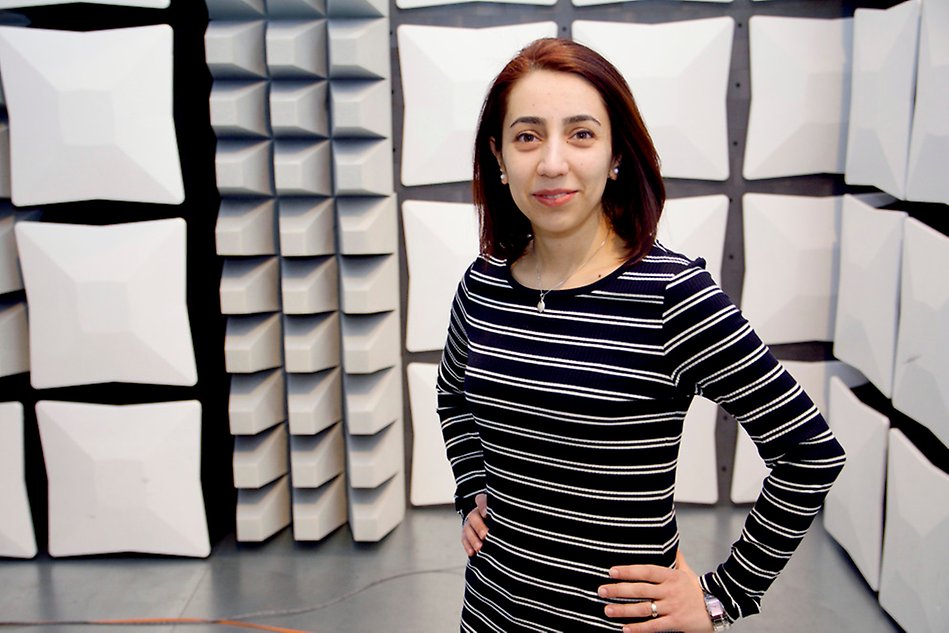Finding small things in big data
Sepideh Pashami uses big data to predict and understand not only what happens when you change certain factors in a process, but why it happens. In a project with Volvo, she is working on a system that predicts the maintenance needs of a truck, before they arise.
After studying at Teheran University and earning her PhD at Örebro University, Sepideh Pashami came to Halmstad University in May 2015. Here, she is involved in several projects that focus on analysing big data, making sense of the data by means of statistical machine learning, predicting effects and understanding not only what happens when you change certain factors in a process, but also why it happens. Currently, she spends one day a week at Volvo AB researching “Data-Driven Predictive Maintenance for Trucks”, a project financed by Vinnova.
”The aim is to predict the maintenance needs of a truck, before they arise. The collaboration between Halmstad University and Volvo Group on predictive maintenance has been going on for a long time, and there are existing solutions. The goal of this project is to improve the prediction accuracy and reduce the number of false alarms”, says Sepideh Pashami, explaining that reducing the false alarms even by a small percentage can have a huge and visible impact when the solution is applied on a large scale for all the Volvo trucks.

”I am also working on another project with Volvo Group, focusing on early detection of the quality issues targeting a group of vehicles instead of individual trucks for predictive maintenance.”
Analysing trucks on the road
Sepideh Pashami is involved in one more theoretical project concerning analysing big data, combining different sources of information, handling streaming data, and providing interactive functionality to communicate more easily to end-users.
”The goal of this project is to develop general methodology, which can address big data challenges and later be used in different domains. The areas of the research include machine learning, distributed algorithms, uncertainty management, data fusion, causal inference and visualisation”, says Sepideh Pashami, explaining that the results of this project can be complementary to the applied project discussed previously.
Reaching a higher level of understanding
A massive amount of streaming data is generated in a large number of trucks. By combining various data sources from trucks and real-time analysis of data, for example, we would be able to create more advanced maintenance solutions, predicting needs of maintenance in trucks while they are on the road.
”One of the research directions, which I am pursuing in this project, is working with causal inference which means analysing the causes and effects of a process in order to draw conclusions that can eventually take into account the effect of changes in underlying mechanism. We are trying to go beyond answering predictive questions, explaining the predicted result by understanding the underlying causes and effects. This is very consistent with the goal of the research programme CAISR, which is going from data to wisdom, reaching the highest level of understanding.”
And where are you now?
”Right now, we have left the data and we are on the second step, which is information. But I would like to go even higher, to the knowledge and understanding levels.”
The reason Sepideh Pashami chose to work at Halmstad University was to move toward the field of Data Analysis for real world problems.
”Halmstad is a very good place for me to continue in that direction. The goal of the lab is to collaborate closely with the industry. It is a great experience for me as a young researcher. I learn how to align the research needs with the needs of the industry. I learn about how companies work and what they expect of us. I think all parties benefit from such collaboration. There are also collaborations between researchers”, says Sepideh Pashami and continues:
”In CAISR, we try to align individual research with the overall goal of the lab, which is creating an aware intelligent system. Due to having a common goal in the lab, we are able to collaborate within the research environment Embedded and Intelligent Systems (EIS).”
Predicting health status in people as well as vehicles
Sepideh Pashami has plans to collaborate with her colleague, researcher and Assistant Professor Jens Lundström.
”We are both interested in learning representations from data. Jens collects data from the smart home and we work with the data collected from vehicles. He wants to predict the status of people’s health and we want to predict the status of the vehicles. There are differences but also similarities that make it interesting to work together. The KK Environment creates possibilities for creating synergies through research and collaboration, similarities, even if we do different things.”
Sepideh Pashami has been given the chance to create her own signature, as a young researcher, through her work.
”Since Halmstad is not a very big university, you have the ability to grow fast as a researcher, with a lot of support from your colleagues. This is something I have found here and it is unique, to be given this opportunity to create my own research.”
Text: Lotta Andersson
Sepideh Pashami
Age: 32
Title: Postdoctoral researcher
Field: Data Mining, Machine learning
Research in focus: Data-driven predictive maintenance for heavy-duty vehicles

